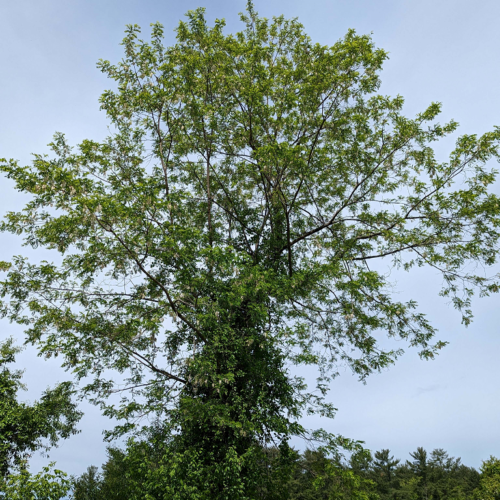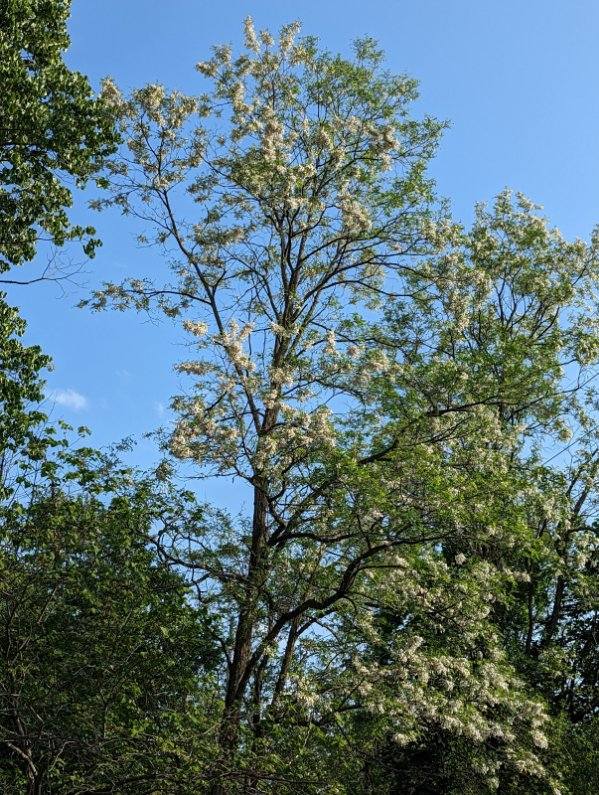Black locust (Robinia pseudoacacia) is a native tree in the family Fabaceae, the legumes, which makes it a relative of peas and beans. Like those plants, it forms association with nitrogen-fixing soil bacteria. The black locust has large fragrant flowers and produces pods as fruit. It grows in full sun, and does not do well in shady conditions. Young trees have thorns, but mature trees lack them. Black locust spreads by root suckers, so some consider it invasive. I rather look at it as a pioneer tree, moving first into an area that is not yet ready to support climax trees (those large trees that tend to dominate old-growth forest, such as oak or white pine). Therefore, from an ecological perspective, it is a keystone species.

Black locust holds ecological value besides nitrogen fixing and acting as a pioneer species. According to Dan Herms, Vice President of Research & Development for the Davey Tree Expert Company, flowering of the black locust coincides with the emergence of overwintering emerald ash borer (Agrilus planipennis), an exotic invasive borer from Asia, which we discussed on last week’s blog.
Black locust therefore is a phenological indicator. Phenology is the study of repeating biological events, in this case flowering. Although flower buds are formed the previous growing year in black locust, the timing of flowering is influenced by climate. Deciduous trees require a period of low -winter temperatures before breaking dormancy, but the timing of flowering is based on warming temperatures. Growing degree days (GDD) is used to determine biological activity. GDD is based on the daily average day and night temperatures. Average overnight temperatures less 50 degrees Fahrenheit (base temperature) gives us the number of GDD. For example, if the difference between day and night temperatures exceeds 50F by 1 degree, we accumulated 1 GDD. Growing degree days are cumulative. In the case of EAB, adult emergence is between 400 to 500 GDD, which also coincides with flowering of black locust (450 to 500 GDD). Therefore, bloom time is an indicator of EAB emergence and a signal for treating susceptible ash trees.
Emerald ash borer does not attack black locust, but is a destructive pest of ash trees. All native ash trees are susceptible to EAB. Since many external signs of damage on infested ash trees are subtle, and the insect itself is very small (exit holes are on the order of ¼ inch), it can be hard to tell when ash trees are infested until the tree is well in decline. Unrestricted, an infestation will girdle trees, leading to their death.

A good portion of my work with Arborjet was developing formulations and methods to treat EAB infestation and save trees. Nothing can fix a broken vascular system, so systemic treatment of trees must be applied before significant vascular compromise occurs. Using black locust as a clock to time applications into ash trees is a very good practice.
Arborjet has developed a formulation for tree injection based on the emamectin benzoate chemistry (the active ingredient was developed by Syngenta Crop Protection, Greensboro, NC, USA). This collaboration led to the development of the TREE-äge® formulation. TREE-äge was independently tested by universities throughout the mid-western states, where the infestation was first identified, including Michigan State University, Ohio State University, and Perdue.
TREE-äge has been certified for two years of protection when injected properly.
Therefore, this rather unassuming tree, which some consider invasive, gives us a heads-up on treatment timing! Systemic injection of trees reduces environmental exposures, and reduces the amount of chemistry in the environment. Done properly, it also reduces exposure to non-target organisms. To date, it is the best option to protect ash trees.
Join me next week when we explore an entirely different tree pest.
~ Signing off for now, Joe



